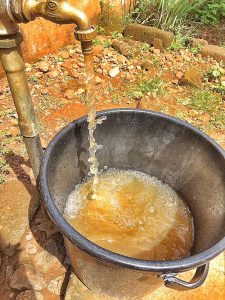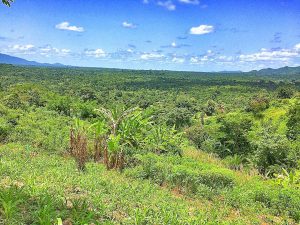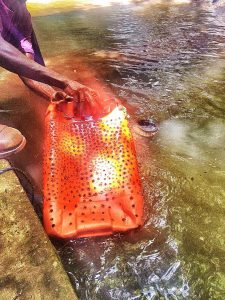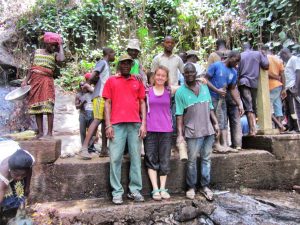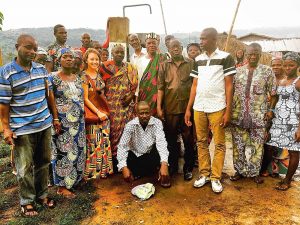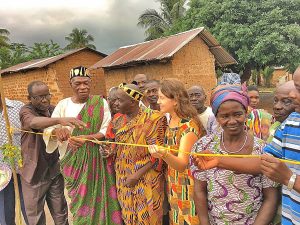This project is made possible through the partnership of Water Charity and the National Peace Corps Association. 
This project has been completed and the updated conclusion report can be read below.
Location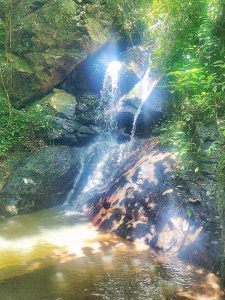
Canton of Apedome, Lavie, Kloto Prefecture, Togo
Community Description
Lavie is located in the prefecture of Kloto, just 13 kilometers away from Kpalime, in a mountainous region that borders Ghana. Lavie is composed of two cantons, Apedome and Rhume, each with a population of about 6,000 inhabitants. Lavie neighbors a popular tourist village named Kpime, famous for its beautiful waterfalls and hikes. This community is surrounded by beautiful green mountains and is abundant in fruits and vegetables. The climate is tropical, and the community consists of lush green, tropical trees, flora, and fauna. It is famous for its tree nurseries, as many individuals from around Togo visit the community for hard-to-find species of trees.
Colette Van Dyke, the Peace Corps Volunteer directing this project reports:
“I feel so at home in my community, and just wake up feeling lucky to be in such a loving and beautiful place. When I wake up in the morning, I have the blessing of being able to see the green, misty mountains in the distance, and breathe in the clean, unpolluted, fresh air. The vegetables and fruits I buy at the local market are always fresh and natural, as my village is abundant in tropical and wild collections of fruits and vegetables. When I walk outside of my compound, I follow a beautiful red dirt road with the green lush surrounding me. Neighbors, friends, school children, always greet me and ask how I am doing when I walk down the street. My favorite time of the year is mango season (around March-April) during which my host brothers and sisters and I sit under the shade of the mango trees, to eat mangoes and talk. To put it simply, life in Lavie is happiness to me.”
The majority of the community members speak French, but the predominant language is Ewe. There are also smaller groups of Kabiye, Moba, and Kotokoli throughout the village. We are a medium-sized community with roughly 12,000 inhabitants in total, and many schools, from kindergarten to high school. There are NGOs working nearby. The majority of individuals in the community rely on crop cultivation for food and income generation. The entire village of Lavie is equipped with electricity and running water, making living a bit more comfortable. Because the region receives heavy amounts of rainfall throughout the year, the fertile land is able to produce abundant amounts of cash crops such as coffee, yams, bananas, and pineapples. While this heavy rainfall is a blessing in this respect, it also poses problems for the water source, as will be explained further below.
Problem Addressed
The heavy rainfall the community receives every year causes problems for the water source. Erosion leaves piping exposed, bruised and vulnerable to breakage. The main water source is a waterfall located up in the mountains. When rain falls, a collection of debris, dust, dirt, leaves, twigs, and feces fall into that open water source and channels out to community members.
To put it simply, this community lacks clean, hygienic, potable water. The village currently relies on an old, broken-down system of water that was constructed over 60 years ago by USAID. The water filter that the entire community relies on consists of a simple plastic container with punctured holes, to keep out leaves and twigs, but does not actually purify water.
The entire community essentially drinks brown, unfiltered water that is channeled through dirty, aging, deteriorated and molding piping. Due to erosion from rainfall, the pipes are exposed, punctured, and burned from years of hot sun exposure. Because of this exposure, the elasticity of these pipes is weak and when rocks, rainfall, or humans step over the exposed piping they are easily cracked and broken. When a pipe is cracked, which happens often, water spews from the pipe, causing a blockage that prevents water from running to the rest of the village. Community members are then forced to shut down the entire water system, starting from the water tower, until the punctured pipe is taped back together. This is a process that takes several hours, and deprives community members of water for periods at a time.
The local health clinic is constantly treating patients due to water-related illnesses. This problem has a huge effect on students, especially girls, who are consistently absent from class due to unsanitary water. The lack of a clean water source creates barriers for female students to keep up throughout the school year, which greatly jeopardizes their potential to graduate and pursue a career. A clean water source would reduce the influx of patients at the already understaffed health clinic and diminish absentee rates at schools. Additionally, the water system serves 2 neighboring villages, with an additional population of 2,000 inhabitants.
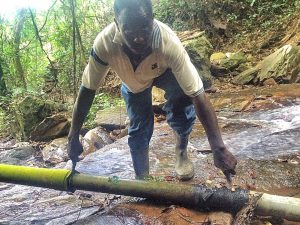 Project Description
Project Description
This water sanitation project will implement the following in the water dam, which is located at the base of the waterfall used as the water source:
First, the five old rotten pipes located at the dam will be replaced with five stainless steel pipes.
Next, a new water filter will be inserted in the dam, which will transform the water into a potable source. An iron fence will be erected around the filter to block leaves and other particles from dirtying and entering the filter.
Next, a cement slab will be constructed with an iron filling that will cover the third dam filling and filter to prevent debris and particles from clogging the filter from above.
A floodgate will be installed at the base of the wall of the dam, or spigot, that will allow water to evacuate from the dam to allow for cleaning. In addition, a vacuum (motor pump) that electrically evacuates water will be installed so inhabitants are not forced to jump into the dam and manually evacuate water with buckets and shovels (a process that takes at least 4 hours). Then two connection pieces will be installed that will connect the water spigot to the piping.
The following are the steps to complete the project and the timeline.
1) Withdrawal of money (Colette Van Dyke) (1 day)
2) Travel to Lome to buy materials (Water Commission Board Members- Mr. Kpetsu and Mr. Agon) (2 days)
3) Return to Lavie with materials (1 day)
4) Announcements and mobilization of the community, by the district. Community Development Committee will execute this (1 day)
5) Collection of sand and gravel with the community, students, farmers, general community members, and water board members(1 day)
6) Transport of materials from the village up to the dam. Various members of the community (1 day)
7) Construction of cement slabs for the dam, 3 local carpenters (3 days)
8) Installation of piping and connection pieces, water technician. (1 day)
9) Installation of filter and metal caging, water technician (1 day)
10) Installation of flood gate, water technician (1 day)
11) Follow up, Colette Van Dyke (one week)
The community will participate in all aspects of manual labor involved in this project and will provide food and water for those working. The community will help mobilize its members to work and oversee the completion of the project in an organized manner. The community is the driving force behind this project, as they have urged Collette since her arrival, to help them improve their water source.
After conducting a needs assessment with the entire community, they listed their water filtration system as the number one pressing need. They are motivated and ready to help in any way they can to ameliorate their water source.
This motivation was witnessed first hand when APCD, Paul Siyanda, came to visit the community. The members of the community were able to organize a community-wide water cleanup day in which they emptied and cleaned the dam. Each times the rainfalls and the water system stops, community members have no choice but to work together to clean, fix, and unclog our filter and dam. This community collaboration is essential to sustaining the water and subsequently lived in the village. Otherwise, the community cannot continue to survive.
Clean water is a base element of life that should be available to everybody but is sadly a problem people are grappling with each day.
The funds will go directly towards all the materials and parts needed to replace old, deteriorated materials (filter, piping, water valves, floodgate, etc.) with new and durable materials. General community members, the Village Development Committee Board, Water Association Board, students, parents, and teachers will assist in implementing the water system. Having those who will benefit from cleaner water involved in the implementation process invests them in the success and sustainability of the end product. Additionally, cleaner water leads to better health, allocating more free time and energy to other activities such as working in the fields, teaching, learning, working, etc.
Project Impact
This project will impact 14,000 people, as well as any visitors to the area.
Peace Corps Volunteer Directing Project
Colette Van Dyke
Monitoring and Maintenance
The community will be able to sustain the benefits of this project by enforcing a strict monthly community contribution plan. Each household will contribute 100 cfa each month that will go towards water repairs, materials, and water clarification. The Water Development Board Members are committed to collecting this contribution each month and will take turns amongst each other to implement this. The local water technicians will then use this money to maintain and make repairs when needed. If a person refuses to contribute, their water source can and will be shut off. The water commission and technician in the community will oversee, and do manual checkups to make sure materials are protected, maintained, and taken care of for future years.
Comments and Let Girls Learn:
According to Colete:
This problem has a huge effect on students, especially girls, who are consistently absent from class due to our unsanitary water. According to the registry at our local hospital clinic, approximately 127 girls were reported to have fallen ill with giardiasis, dysentery, diarrhea, gastroenteritis, or typhoid just in 2014. In 2015, 169 cases of these waterborne diseases among girls were reported in our registry. The lack of a clean water source creates barriers for female students to keep up throughout the school year, which greatly jeopardizes their potential to graduate and pursue a career. A clean water source would diminish absentee rates at our schools, especially among the girls. In general, clean water through a new and improved system will save the entire community money and time that could be used towards raising families or sending children to school, which paves the way for a brighter future.
When I arrived in Lavie in May 2015, two days into my welcoming the community members took me up to their water source to explain where the most development was needed. This took me aback, as it usually takes weeks for community members to reveal community needs. I was pleasantly surprised by their motivation and devotion to this project. After they had detailed all the problems with their water system, I promised them I would do my best to help them out. Afterwards, one of my work partners whipped out a bottle of the local drink (sodabe), and we all toasted to the year ahead of us, and that I could bring good work and blessings to their community.
On our hike back down from the water dam, one of my work partners spotted a porcupine hiding amidst the brush. He smiled and looked back at me, and I looked back at him, puzzled. He excitedly told me he had just spotted a porcupine, and I thought “cool! so what?” What made it special was what he told me next. He explained to me that in Ewe culture, a porcupine is a symbol of hope for those who are in pain or in need of help. When the quills of a porcupine are engaged, they are filled with air, allowing them to float. This buoyancy is symbolic of the ability to stay “above water”, to remain calm in the face of emotional waters. In other words, when life casts you problems, you invoke porcupine energy to keep you afloat upon troubled waters. My work partner then told me that perhaps it’s a sign that I am a source of new hope for Lavie. I mulled over this the entire hike down. I was just presented with my first major task, a water sanitation project, and I was hoping I could be that “hope” for her new community. I hoped that I could lessen the suffering even just a little. I had no idea how I was going to tackle such a project, but I hoped that I could invoke this “porcupine energy” to keep me afloat and balanced, to help find a clear solution amidst my community’s problems.
Today, I can happily say that Water Charity is that solution, that hope for my community. I’m sending a big Thank You to Water Charity for all the work you do!
Lavie Water Project – Togo – Conclusion
Colette Van Dyke Reports (in 2 phases):
Water Sanitation Part 1: Local Water Filtration System
Your Story: The impact our Water Charity Let Girls Learn grant had was deeply felt by community members and surrounding villages throughout my region. Through dedication, teamwork, perseverance, and commitment my community was able to turn an unhygienic water source into a clean and consistently running spring. Over the course of one month, my community worked together to install new piping, a new filter, and cement over our water dam. These simple steps allowed for an entire community to reduce the percentage of individuals who fall sick due to our previously unsanitary water source, thereby diminishing absentee rates at our schools. After a series of randomized household surveys, visits to the school and health clinic, the findings from this grant proved to be generally positive. 
Goals Achieved, Changes in Initial Objectives, and Community Feeling:
In a study conducted by school officials for the academic year 2015-2016, our total absentee rate for students at the middle and high school level hovered at around the 29% mark. Towards the end of academic year 2015-2016 and at the beginning of academic year 2016-2017, the absentee rate among middle and high school students is now at around the 24% mark. When a work partner and I conducted surveys, more than half of the participants (composed of students, school administration, and teachers) responded that one of the top potential reasons for this decrease is due to improved health. When my work partner and I visited the primary health clinic in our community, we were able to retrieve statistics from clinic staff regarding rates of girls who have fallen ill due to water-related diseases. In 2015, our registry reported 169 cases of illness regarding waterborne diseases. However, thus far in 2016, our health clinic has reported 112 cases. This data was compiled from reports school officials and health clinic staff provided to us using statistics acquired over a period of time. In order to further corroborate the positive trend in our findings, my work partner and I decided to conduct randomized household surveys to find how the water quality has affected general community members. After conducting 20 randomized household visits, we found that around half of the families surveyed found a) a noticeable difference in water quality and b) generally improved quality of life due to this our water sanitation grant.
Capacity and Skills Built: General community members, our village development committee board, water association board, students, parents, and teachers assisted in implementing our water piping and materials. They took care of all the manual labor, such as digging trenches, collecting sand and gravel, transporting materials up to our source, etc. Our two water technicians who work on the upkeep of our water piping learned how to manage and budget monetary monthly contributions. Because of these technicians, the maintenance of our water system is sustainable.
Sustainability: The sustainability of our project has posed some difficulties but also some opportunities for community members. After the completion of our water sanitation installment, the community selected two trusted inhabitants of the community to oversee the maintenance of our water system. It has been difficult holding these individuals accountable, and ensuring that they complete their duties. After our first community reunion, we held these individuals responsibly and questioned them on the difficulties of the job. They were able to point out some improvements they could make, and this has been fruitful in holding them accountable. As of now, I believe if the community continues to hold quarterly meetings with all interested stakeholders, the sustainability of this portion of our water project will go much more smoothly.
Another aspect of our water project hinges on a monthly contribution of 100cfa from all community members. The president of our water association has been tasked with collecting the money, however, he has been unable to do so consistently due to time conflicts. We are in the process of appointing other members within the water association board to take on the responsibilities of this post.
Unexpected Events and Recommendations: Unexpected events and recommendations include the following: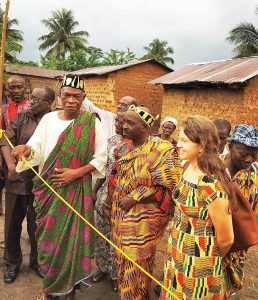
· Organized, collaborative, and cooperative community contribution. The community came together to collect gravel, carry cement up to our water dam, install piping pieces, clean out the dam, and many other tasks. I was very surprised to see how much my community was motivated and cooperative. I was very proud to see them coming together like a team to complete a task for the greater good of the community.
· I did not expect the water maintenance system to break down as early as it did. The initial organization of maintaining and protecting the newly installed water system took some time to figure out in the beginning. However, after our community meetings, we were able to establish a rhythm that worked for our maintenance individuals and the community.
· After my community saw how our impactful and beneficial our project became, I began receiving more interest in work offers from inhabitants in the surrounding villages. I also began receiving requests for additional water sanitation projects that I simply cannot accommodate any longer.
· As for recommendations, I would recommend discussing water maintenance details before initiating another water sanitation project. The maintenance relies on the motivation and dedication of the community, and if this is lacking, the sustainability of this project crumbles. I would recommend having a clearer maintenance vision before engaging in any other funded project.
Lessons Learned and Promising Practices: This water sanitation grant was my first real-time taking out a grant. I learned how to orchestrate the details of a grant, and control many moving parts. I learned how to delegate tasks, manage a budget, assign roles and responsibilities, and keep an organized count of actions performed. I learned how to monitor progress and conduct follow-up work to measure results. These are promising practices that can be carried on into any future large-scale funded projects I conduct.
Water Sanitation Part 2: Replacement of Piping for Cleaner Water in Lavie
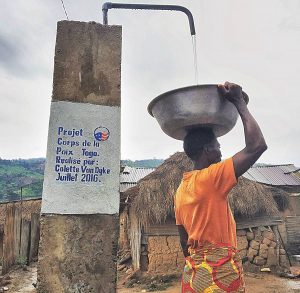 Your Story: The first part of our water sanitation grant focused on improving the quality of our water through better piping, and a new filter. This second part of our Let Girls Learn grant focused on adding and extending piping as well as constructing water fountains as a way to improve access to our water to all community members. This involved building and implementing water fountains, and extending piping to exterior communities. The impact this Let Girls Learn grant had was deeply felt by community members and surrounding villages throughout my region. Over the course of two months, my community worked together to install new piping, water fountains, and extend pipe pieces to neighboring districts. During our randomized household surveys, 17 out of 20 houses reported they benefited greatly from the implementation of these water fountains. In addition, 16 out of 20 houses reported that the amount of time spent fetching water was reduced significantly due to the closer proximity of our water fountains. The way my work partner and I conducted follow-up work involved selecting 20 households within our district, and performing household surveys in order to garner responses to a series of questions related to our water grant. In addition, we visited the local health clinic and central school to measure the impact of this increased access to water affected these two populations. In general, our findings proved generally positive as we found the majority of community members benefited greatly from this grant.
Your Story: The first part of our water sanitation grant focused on improving the quality of our water through better piping, and a new filter. This second part of our Let Girls Learn grant focused on adding and extending piping as well as constructing water fountains as a way to improve access to our water to all community members. This involved building and implementing water fountains, and extending piping to exterior communities. The impact this Let Girls Learn grant had was deeply felt by community members and surrounding villages throughout my region. Over the course of two months, my community worked together to install new piping, water fountains, and extend pipe pieces to neighboring districts. During our randomized household surveys, 17 out of 20 houses reported they benefited greatly from the implementation of these water fountains. In addition, 16 out of 20 houses reported that the amount of time spent fetching water was reduced significantly due to the closer proximity of our water fountains. The way my work partner and I conducted follow-up work involved selecting 20 households within our district, and performing household surveys in order to garner responses to a series of questions related to our water grant. In addition, we visited the local health clinic and central school to measure the impact of this increased access to water affected these two populations. In general, our findings proved generally positive as we found the majority of community members benefited greatly from this grant.
Goals Achieved, Changes in Initial Objectives, and Community Feeling:
In a study conducted by school officials for the academic year 2015-2016, our total absentee rate for students at the middle and high school level hovered at around the 29% mark. Towards the end of the academic year, 2015-2016 and at the beginning of the academic year 2016-2017, the absentee rate among middle and high school students has stayed stagnant at around the 23-24% mark. When my work partner and I conducted surveys among 30 subjects in the school community, more than half of the participants (composed of students, school administration, and teachers) responded that one of the top potential reasons for this decrease remained at “improved health”. When my work partner and I visited the primary health clinic in our community, we were able to retrieve statistics from clinic staff regarding rates of girls who have fallen ill due to water-related diseases. In 2015, our registry reported 169 cases of illness regarding waterborne diseases. However, thus far in 2016, our health clinic has remained constant from our previous follow-up work, at 112 cases.
This data was compiled from reports school officials and health clinic staff provided to us using statistics acquired over a period of time. In order to further corroborate the positive trend in our findings, my work partner and I decided to conduct randomized household surveys to find how the water quality has affected general community members. After conducting 20 randomized household visits, we found that around half of the families surveyed found a) a noticeable difference in water quality, b) generally improved quality of life due and (c ) more time saved to perform other activities, due to improved access to water, thus our water sanitation grant.
Capacity and Skills Built: Our water commission has learned how to budget and collectively organize themselves to collect our monthly community contribution. Each month, water commission members take turns in making the rounds and talking to various households. Each water commission member has been trained in how to log and categorize our community logbook. These are skills that will be carried on to the future.
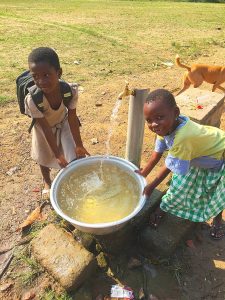 Sustainability: My community has been able to sustain the benefits of this project by enforcing a strict monthly community contribution plan. In the four months since my community completed this grant, each household has been able to contribute 100 cfa each month that will be saved towards water reparations, materials, and water chlorification. Our water development board members have done a fantastic job of collecting this contribution each month and will continue to take turns amongst each other to implement this. They record the savings in a budget book, with the name of each household, as well as their contribution. If a household refuses to contribute, they are at risk of having their water source shut off. Our local water technicians have not tapped into our collective funds as of yet, because no major repairs have been needed.
Sustainability: My community has been able to sustain the benefits of this project by enforcing a strict monthly community contribution plan. In the four months since my community completed this grant, each household has been able to contribute 100 cfa each month that will be saved towards water reparations, materials, and water chlorification. Our water development board members have done a fantastic job of collecting this contribution each month and will continue to take turns amongst each other to implement this. They record the savings in a budget book, with the name of each household, as well as their contribution. If a household refuses to contribute, they are at risk of having their water source shut off. Our local water technicians have not tapped into our collective funds as of yet, because no major repairs have been needed.
Unexpected Events and Recommendations: An unexpected positive result of this grant occurred towards the end of our project. One of the neighboring districts in our community caught on to the work we were doing, and collectively rose money to extend our piping to their community. The motivation and commitment my community exhibited has been uplifting and inspirational for me. This collective action has motivated me to continue working on projects such as this.
Another unexpected positive result was the publishing of our grant in WorldView magazine. I was also surprised to see how direct excerpts from my initial grant application were directly pasted into the article. This grant not only aided an entire community with cleaner, potable water, but also introduced the dedication and hard work of my community to the entire world.
Because of work commitments, I was not able to closely monitor the progress of this grant as closely as other grants. Due to my absence, I was not able to partake in community labor and feel my lack of presence made community members feel I was not supportive or didn’t care. In the future, I would recommend that I try my best to be present for major grants such as this.
Lessons Learned and Promising Practices: Through this grant, I was able to witness the motivation and work capacity my community is capable of. When put to the test, I have seen that my community is capable of accomplishing so much. I also learned that a grant that is well written is capable of not only receiving funds, but also serving as a role model to other volunteers.
Personal promising practices include strong writing skills, which convey the need of the community and address the 5 W’s (who, what, when, where, why). In terms of my community, promising practices I witnessed include the ability to mobilize and organize a community to execute a major goal. In addition, our water commission has developed a sustainable, and organized method of collecting water maintenance funds. They record their collections in a community logbook and maintain this logbook monthly. These practices can and will be continued into the future. In summary, these practices are definitely assets my community can capitalize on to contribute to future development.
